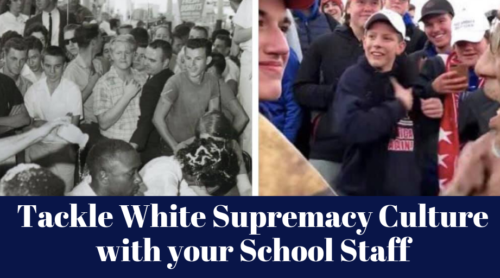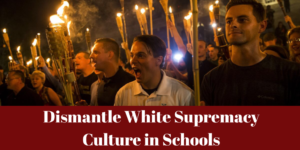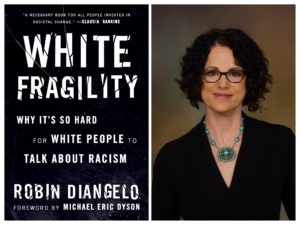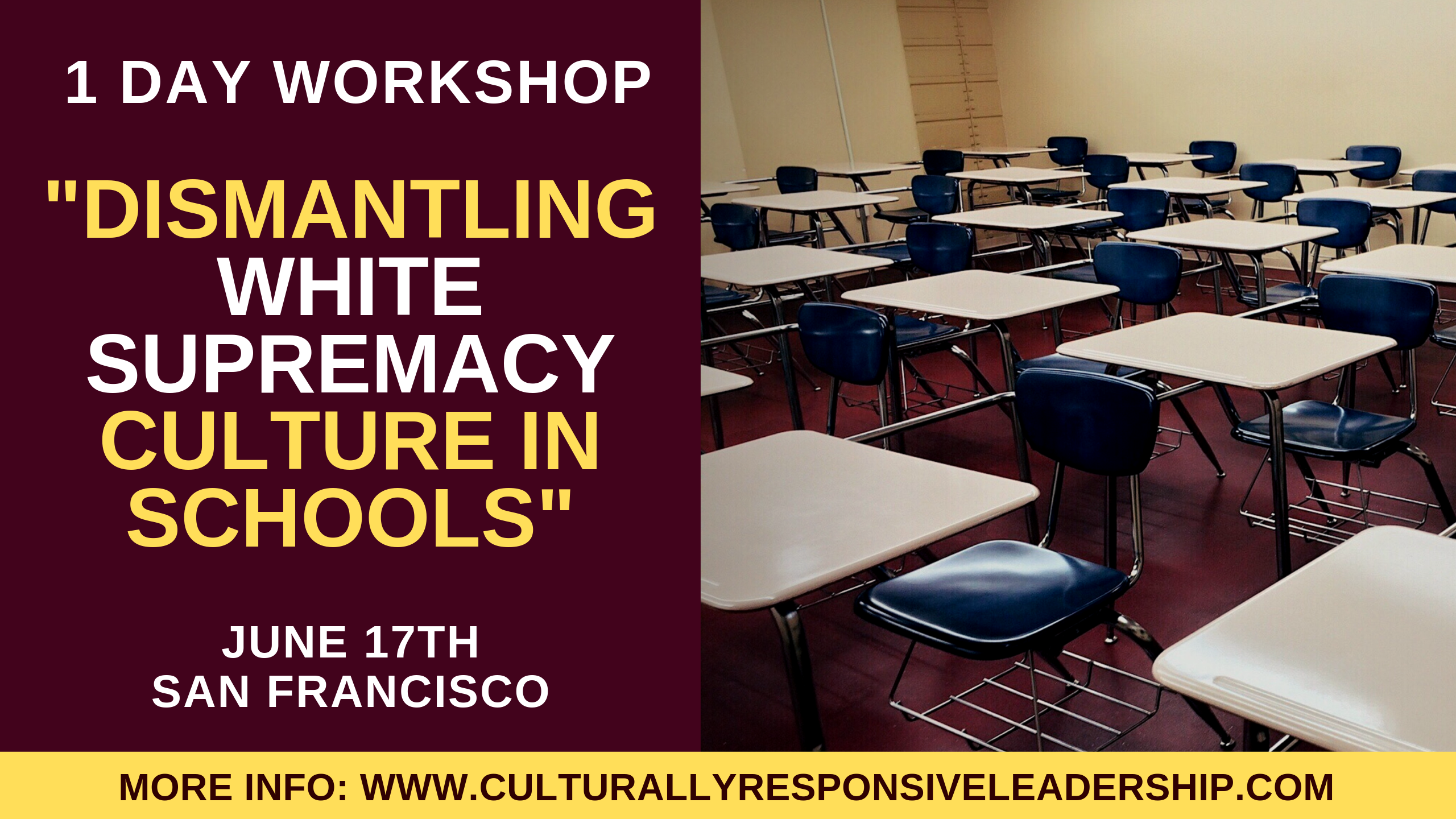How to Explore White Supremacy Culture with School Staff
We should address White Supremacy Culture in our schools, but where do we start? What conversations can you have with staff? See what I observed and learned from starting this work with my school.
How we got to White Supremacy Culture
In the first post about White Supremacy Culture (WSC), I wrote about what WSC was and why it was necessary to address it. In short, our school staff needed to go deeper, be more direct, and get more controversial. As a staff, we were previously dancing around the idea of racism and social justice. We tried to talk about norms, and culturally responsive teaching, and liberation.
In addition, we discussed restorative justice and implicit bias. But it wasn’t enough. It fell flat. It was overly simplified. We didn’t have a shared vocabulary or a shared understanding of what the enemy was. Not a person, but a framework of ideas; White Supremacy Culture. We needed to go there.
So we did.
Working through My Fear and Anxiety
I won’t even front. I was scared to open up this can of worms. Me, a young Black man, creating space to talk about White Supremacy Culture?
Shit. I was scared.
Who knew how it would go. Resistance, tension, disengagement. All possibly leaving me more ostracized than I already was, being a leader with high expectations and a high bar for equity work. Would I be attacked? Would I be judged? Would I be written up?
But, I recently heard that senses and instinct are heightened when you are scared. This fear helped to focus my plan and get more feedback that I normally do. This resulted in nearly 8 drafts of the agenda! I talked with my many coaches, colleagues, and team. The morning of, my Assistant Principal and I made a list what could go wrong and how we would proactively address it. That was hella helpful.
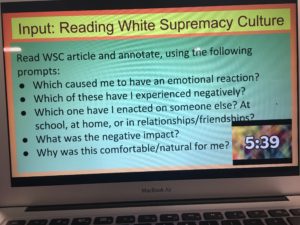
Not an ordinary Staff Meeting
We packed into the library on a cold Tuesday afternoon in December. Music was playing and you could feel the tension in the air. It was clear that we were doing something a little deeper that day. I worried that people would be late or some would conveniently miss the meeting, but a few minutes after our start time, the room was packed.
Damn. This was really going to happen.
We started with some games, Guess Who and Apples to Apples. Racial Equity books were on display around the tables, and dance music was playing. The game was filled with laughter, and then it was passed to me, to transition us into “the work.”
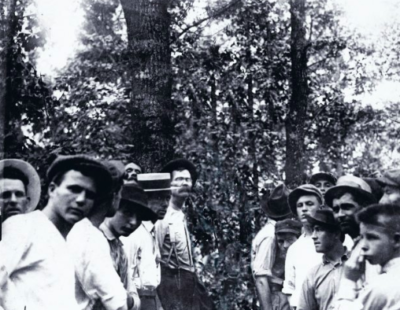
That was a hard segway, but we made it. I did quite a bit of framing, a picture of our students at graduation, a fish in water, a picture of boulders, and a Ken Gonzalez’ images of erased lynchings. That shit hit hard. I connected the unexamined white folks in pictures of lynched Africans, to the unexamined culture of white supremacy, to the invisible water that the fish are swimming in. That’s where we are going. I even shared the fear I was bringing into the meeting, but that I was going to push through.
Highlights
There were many highlights, the real-life examples of equity terms, the pin drop silence while we watched Robin DiAngelo talk about White Fragility and “being less white.” There was the moment when a staff member said, “I want to hear what people have to say about that video.” There were 5 facilitators and the nuances of sharing leadership were challenging and artistic. Watching staff do a matching activity with WSC and discuss informally was magical. This was it. This is what we should be talking about (or usually not talking about). This is one of the missing links in the chain. I can’t believe we found it.
What an experience. It was spectacular.
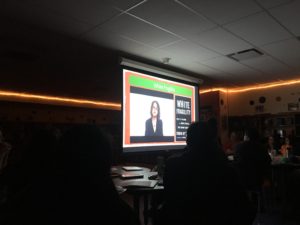
What can you do with the 13 Characteristics of WSC?
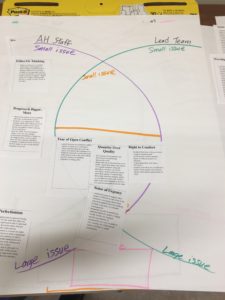
We were semi-successful in having our Leadership Team try to sort the 13 characteristics into 2 groups “big issues with our staff,” and “small issues with our staff.” We used a graphic organizer to help with the sort, but this allowed for our team to have a deeper understanding of WSC. Zaretta would call this, “chew,” also promoting some “structured academic conversation.” Done in small groups, this process allows for a team to determine focal areas to address. One pitfall was that we missed the personal connection and jumped straight to outside forces.
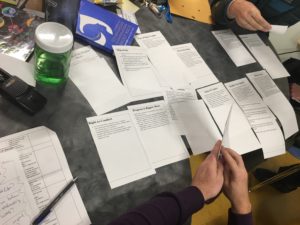
For our larger all staff meeting, we created examples of WSC in schools (quotes and practices) and asked trios to match the description of a WSC element such as Individualism, with its corresponding examples. This served 3 purposes:
- Staff moved past theoretical to tangible examples
- Folks got dissect their own practices
- Sparking the question of ‘what do we do about WSC’?
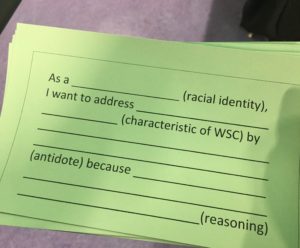
One great activity we closed with, was asking participants to make a personal commitment to address WSC in their interactions. First, they selected an element of WSC that they perpetuate (whether they were white or a person of color). Next, they wrote how they wanted to address it (see antidotes in original Tema Okun article) and give reasoning. After writing this on a card with corresponding sentence frames, members shared their commitments in mixed-race small groups.
Personal. Boom.
Action. KaBoom.
Lateral and public accountability. Atomic Bomb.
Some Prompts for Discussing WSC
Personal
- Which have negatively affected me? How did it make me feel?
- Which have I perpetuated? What was the effect?
- Even though I know that it can be negative, why was it comfortable for me to do this?
- Which antidote could I use to address this pattern?
- What support do I need?
Group
- What norms would we need to address WSC and facilitate antidotes?
- How would things be different if we had less WSC?
- Which have shown up with other staff, with students, with parents?
- What are we gonna do about this?
Comments and Feedback Highlights
- “Can we hear from more people of color about WSC?”
- “Is there a deeper version of these terms?”
- “I want to talk about how this shows up in our school”
- “This got me thinking a lot.”
- “How can I bring this to my students and classroom?”
- “When are we coming back to this?”
- “I feel like this is for white people, and it’s happening on my time. What is there for people of color?”
- “I want to apply this to curriculum”
- “I don’t want to discuss this, these terms are uncomfortable for me. We don’t need affinity groups.”
- “This pushes my thinking.”
- “I went home and talked to my friends about this. They didn’t get it.”
- “I feel fortunate to be at a school discussing this. This is why I signed up to be an educator.”
What I learned
- Real stories and examples matter
- The framing of a meeting like this is huge
- It’s important to stay focused on self
- Multimedia matters such as videos, pictures, and music
- White Fragility understanding was a prerequisite
Conclusions
The work obviously is not done, just by naming WSC as an issue or having a better understanding of it. However, by setting the right conditions, a group can decide that they want to go deeper. (And we did, more on this later) Now we can make connections to WSC as we talk about assessing student work, adding social justice lessons to our curriculum, and promoting more group work. Now when we talk about Zaretta’s work, PBL, or community building in the classroom, we know why. We are fighting White Supremacy Culture and promoting equity and equality. We are fighting patriarchy and domination by one group.
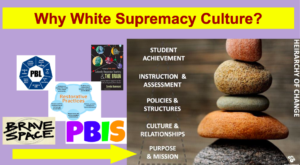
Culturally responsive leaders: When you feel scared, it means you might be onto something. You just need to figure out the best way to get there. Revise, revise, revise, just like we want students to do in deeper learning. You can only learn by doing, especially if you can’t find anyone who has led this work. And something I recently learned from the National Equity Project, is that this work is complex. We won’t know how to go about doing this work until we start it and adjust. But we must do it.
We MUST do this work.
You MUST.
For those who want to explore this heat more about what I learned leading this work, sign up for my one day workshop.

